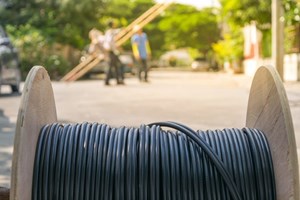Kinetic to bury over five miles of fiber optic infrastructure following devastating Iowa tornado
(UI) – Kinetic is investing $250,000 to replace destroyed communications infrastructure with a buried fiber optic solution following extensive damage done by a May 21, 2024, tornado across Adair County, Iowa.

This effort will bring more than 28,500 ft (about 5.4 miles) of new fiber to more than 320 Greenfield locations. There is no cost to the state, the county, Greenfield or Kinetic customers.
This investment will add to the already existing 10,600 ft (about 2 miles) of Kinetic fiber optic cable in the area. Kinetic's Iowa-based fiber network, about 12,400 miles, is 16 times larger than the total length of Iowa's 782 miles of federal interstates.
“Kinetic’s generous investment to replace and upgrade Greenfield’s fiber infrastructure not only helps this community rebuild, it also intends to fast-track construction, restoring service and providing a sense of normalcy as soon as possible while recovery efforts continue,” said Governor Kim Reynolds.
In the aftermath of severe storms, Kinetic prioritizes rapid internet restoration, leveraging a vast network of over 489,000 miles of cable and the dedication of more than 3,000 technicians across 18 states. This approach ensures that communities don’t need to wait weeks for essential services.
Various other projects across the nation are underway to upgrade underserved areas to fiber, enhancing access to essential services and fostering local economic growth.
In the hours following the tornado, Kinetic assembled a disaster response team of engineers, communicators, customer service representatives, field employees and technicians to work with local authorities and utility companies to assess and evaluate damages while also developing solutions to withstand nature's toughest encounters in the future.
An engineering process of this magnitude typically takes multiple months, but Kinetic routed an engineering plan for approval in just days, according to Rich Murtha, Kinetic’s senior vice president of Outside Plant Engineering & Construction and a former U.S. Marine with experience working as a FEMA disaster specialist. The team’s engineering plan was approved by the city in about two weeks.
As recovery and clean-up concludes, construction of the 28,500 ft of fiber has an expected completion as soon as August. Once the fiber optic broadband service launches, customers will experience symmetrical download and upload speeds along with enhanced security benefits.
“I am thrilled to see Kinetic's commitment to investing $250,000 to upgrade our hometown’s damaged infrastructure with fiber. The decision to bury fiber optic cables will not only provide better weather resilience, but also ensure 99.9% reliability and blazing fast speeds for our residents,” said State Rep. Ray Sorensen (Iowa-R).
“With the addition of 28,500 new feet of fiber in Greenfield, this investment will undoubtedly have a positive impact on our town’s economy, bringing reliable and high-speed internet to our residents and businesses."
After assessing the destruction of the town’s communications infrastructure, the team quickly identified the need to transition to a more sustainable, buried fiber optic network.
Buried cables in some communities are inherently better protected against the elements than other technologies, reducing the opportunity for loss of service, even in the face of future storms or natural disasters.
Kinetic will use its “resi-plow” technology to increase efficiency, speed and quality of installation while minimizing impacts on the environment, the city, and local property. The company has invested $2 million in the technology, which also enables faster repairs and reduces downtime if the fiber is damaged.
With this upgrade, more Greenfield residents will be eligible for faster internet speeds. Fiber is more reliable than other technologies, experiences fewer outages, and doesn't slow down when more people use it in the same way cable or fixed wireless does. It’s also not dependent on weather conditions, like satellite internet.
Replacing infrastructure immediately after a storm all comes down to time and access. Fiber takes time to place underground, and it is expensive. So, while technicians work to restore service rapidly and safely, there’s a constant balancing act to get essential service up and running.
“As you can imagine, these families and communities have been traumatized,” said Murtha. “The last thing these folks need is to wait for permits or supplies to be readily available. So, through our staging supply chains around the country, we rapidly responded to Mother Nature. During this whole process, the city and local authorities have been great to work with.”
Related News
From Archive

- Glenfarne Alaska LNG targets late-2026 construction start for 807-mile pipeline project
- U.S. water reuse boom to fuel $47 billion in infrastructure spending through 2035
- $2.3 billion approved to construct 236-mile Texas-to-Gulf gas pipeline
- Major water pipe break in Puerto Rico hits over 165,000 customers
- Potomac River Tunnel project enters construction phase beneath Washington, D.C.
- Pennsylvania American Water launches interactive map to identify, replace lead water service lines
- Trump's tariffs drive $33 million cost increase for Cincinnati sewer project
- Utah city launches historic $70 million tunnel project using box jacking under active rail line
- Tulsa residents warned after sewer lines damaged by boring work
- Fatal trench collapse halts sewer construction in Massachusetts; two workers hospitalized



Comments